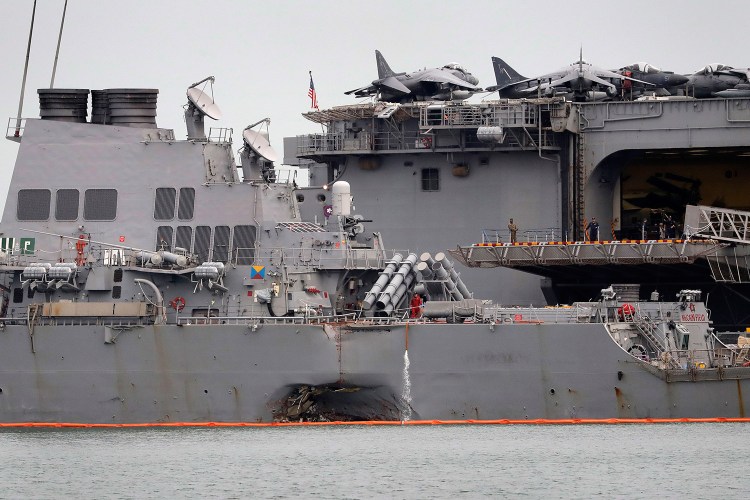A spate of accidents involving the Navy’s Pacific Fleet, including two deadly collisions in just over two months, are likely the result of human error, not mechanical malfunction, analysts and former Navy officers say.
The intense tempo of operations and long deployments at sea could mean crews are not getting enough training before being deployed, several experts say. That may help explain four incidents in the past year involving ships from the 7th Fleet crashing or running aground, including the two collisions this summer that resulted in at least 17 deaths.
“Even one Navy collision is unusual. Having four mishaps relatively closely spaced in time and in the same general operating region suggests a pattern,” said Loren Thompson, CEO at the Lexington Institute, a nonprofit focused on security issues. “The collisions are so different that they don’t suggest a mechanical or design issue, they suggest a human-error problem.”
At least 10 U.S. sailors have been missing since the USS John S. McCain collided Monday with an oil tanker in the Strait of Malacca, near Singapore, one of the busiest shipping corridors in the world. And the USS Fitzgerald was struck off the coast of Japan on June 17 by a much heavier container ship, the Philippine-flagged MV ACX Crystal, killing seven U.S. seamen. Both destroyers were built by Bath Iron Works in Maine in the early 1990s.
“This is more of a systemic problem with how the Navy is able to train and maintain ships during deployments,” said Bryan Clark, a former Navy officer and a senior fellow at the Center for Strategic and Budgetary Assessments, a think tank in Washington, D.C.
The Navy has shrunk the size of its overall fleet by 20 percent since 2000, putting a strain on remaining ships and crews, he said.
STRAIN ON JAPAN-BASED FORCE
In February, the USS Antietam, a guided-missile cruiser, ran aground near the U.S. base in Yokosuka, Japan, and in May, the USS Lake Champlain, another Ticonderoga-class guided-missile cruiser, crashed into a South Korean fishing boat.
 The Pacific Fleet is at the front line of Chinese territorial claims in the South China Sea and aggression from North Korea. The strain on the Japan-based force may reflect challenges confronting other naval fleets, such as U.S. ships in the Mediterranean, Clark said.
The Pacific Fleet is at the front line of Chinese territorial claims in the South China Sea and aggression from North Korea. The strain on the Japan-based force may reflect challenges confronting other naval fleets, such as U.S. ships in the Mediterranean, Clark said.
“The concern the Navy has is that the Japan force, because it is the most highly stressed, is the canary in the coal mine,” he said.
On Tuesday, CNN reported that a steering malfunction may have occurred before the McCain crashed. A spokesman for the 7th Fleet would not confirm that report Tuesday afternoon. The McCain passed a readiness inspection in May, the Navy said.
“We aren’t going to discuss possible causes, events or circumstances leading up to the collision,” Lt. Paul Newell said in an email. “The investigation will determine what happened. We’re focused now on finding our missing sailors, and on supporting their families and the crew.”
As of Tuesday evening, two of the McCain’s missing seamen had been identified – Logan Palmer of Illinois and Ken Smith of Michigan, The Associated Press reported.
LESS TIME FOR CREW TRAINING
Two commanding officers on the Fitzgerald were removed from their posts last week after an investigation concluded “flawed” teamwork and “inadequate leadership” contributed to the collision.
Clark said the reduced number of ships and the heightened stress on the remaining vessels and crew are especially apparent in units like the 7th Fleet. Its fast-paced operations don’t leave enough time for deliberate maintenance and training programs in port before ships head out again.
“There is a systemic trend between less time to train and a much higher up-tempo when they are underway,” he said.
Training and maintenance issues with Navy ships stationed overseas were highlighted in a 2015 report from the Government Accountability Office. The Navy has improved on maintenance since the report, but training is still lacking, said Jerry Hendrix, a former Navy officer and senior fellow at the Center for a New American Security in Washington, D.C.
“We get some indication that there is a drop-off in bridge team efficiency. … What we have done is shortened training, put it in simulators. These bridge crews are not allowed to fully come together as teams,” Hendrix said.
BIW A MAJOR SHIP PRODUCER
On Monday, Adm. John Richardson announced that all 277 Navy ships worldwide would take an “operational pause” to review basic seamanship, teamwork and other fundamentals to ensure safety. A broader review by the Navy and its inspector general will assess the 7th Fleet’s performance, including personnel, maintenance, navigation capabilities, training and other measures.
The McCain and Fitzgerald are Arleigh Burke-class destroyers, multi-use ships that are the backbone of the Navy’s longest-running surface vessel program. Both ships were built at Bath Iron Works in the 1990s. The shipyard has produced 35 Arleigh Burke-class ships, more than half the number in active service. The most recent destroyer was launched last year.
On Tuesday, BIW spokesman David Hench referred all questions about the collision and investigation to the Navy.
BIW, a subsidiary of General Dynamics, has a small group of employees in Yokosuka, the 7th Fleet headquarters, to assist with periodic ship maintenance and upgrades, Hench said. He did not know if any BIW employees would be deployed for repairs on the McCain.
Peter McGuire can be contacted at 791-6325 or at:
pmcguire@pressherald.com
Twitter: PeteL_McGuire
Send questions/comments to the editors.



Comments are no longer available on this story